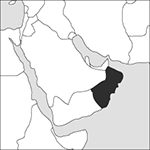
Source: MAPS IN MINUTES™ © RH Publications (1997)
Capital:
Muscat
Area:
309,500 sq km (119,499 sq miles)
Population:
3,154,134 (2013 est)
Currency:
1 Omani rial = 1000 baiza
Religions:
Ibadhi Muslim 75.0%; Shia Muslim 5.0%
Ethnic Groups:
Arab; Baluchi; Indo-Pakistani; African
Languages:
Arabic (official); English; Baluchi; Urdu
International Organizations:
UN; Arab League; GCC; Non-Aligned Movement; WTO
A country situated on the eastern corner of the Arabian peninsula.
Physical
Oman has a coast on the Arabian Sea, and inland it borders on Saudi Arabia and Yemen. Mountains rise steeply from a narrow coastal plain to a plateau which merges into the desert of the ‘empty quarter’ or Rub al-Khali.
Economy
Crude oil and natural gas are important export industries and sources of government revenue. The industrial base also includes construction and the production of cement, copper, steel, chemicals, and optical fibre. The coastal plain is fertile, producing fruit and vegetables. Oil production sank to its lowest point in 2007, but has since increased, using enhanced oil recovery techniques, and reached a record high in 2015. In addition more reserves have been found both onshore and offshore. Oman’s large gas reserves are being exploited for domestic use, as a raw material in a growing petrochemical industry, and for export. Oil reserves will last at least another fifteen years and gas rather longer.
History
Oman was a trading outpost of Mesopotamia, settled by Arabs in the 1st century ad. It was conquered for Islam in the 7th century. Expelling Portuguese incursions by 1650, the Omanis created a maritime empire with possessions as distant as Mombasa and the island of Zanzibar in East Africa and trade contacts with south-east Asia. By 1754 Ahmad ibn Said had expelled Turkish invaders and founded the sultanate that still rules Oman. Under Said ibn Sultan Sayyid Oman was the most powerful state in Arabia in the early 19th century, controlling Zanzibar and the coastal regions of Iran and Baluchistan (now mainly in Pakistan). Tension frequently erupted between the sultan of Oman and the interior tribes. Oil, now the country’s major product, began to be exported in 1967. In 1970 the present ruler, Sultan Qaboos bin Said (1940–2020), deposed his father Said bin Taimur in a palace coup. An uprising by left-wing guerrillas, the Popular Front for the Liberation of Oman, was defeated in 1975. A member of the Arab League, Oman managed to remain largely unaffected by both the Iran–Iraq War and the Gulf War. In 1996 Sultan Qaboos decreed Oman to be a hereditary absolute monarchy. However, the State Advisory Council was elected by universal suffrage in 2003. Demonstrations in 2011 inspired by the Arab Spring resulted in some reforms but did not endanger Sultan Qaboos’s regime.
- Chrysippus’ dog
- chrysoberyl
- chrysocolla
- Chrysophyceae
- Chrysophyta
- chrysotile
- Chrétien, Jean (1934)
- Chrétien, Jean-Loup Jacques Marie (1938– )
- CH star
- ChubuSat-1
- chuck-a-luck
- Chu His (1130–1200)
- Chulalongkorn (1853–1910)
- chung or shu
- chunk
- Chu, Paul Ching-Wu
- CHUR
- Church, Alonzo (1903–95)
- Church, Benjamin (1639–1718)
- Church constant
- Churchillian orogeny
- Churchill, Lord Randolph Henry Spencer (1849–95)
- Churchill, Sir Winston (1874–1965)
- Church of England
- Church–Rosser